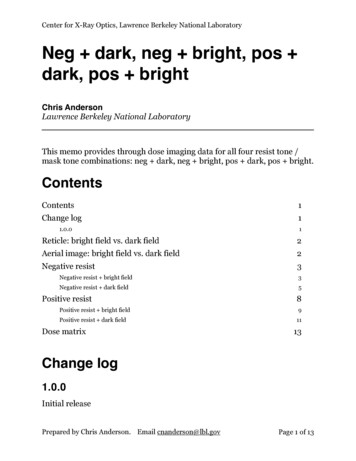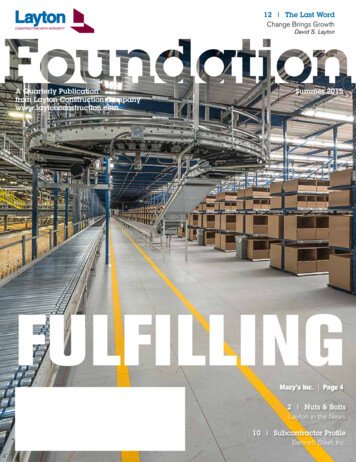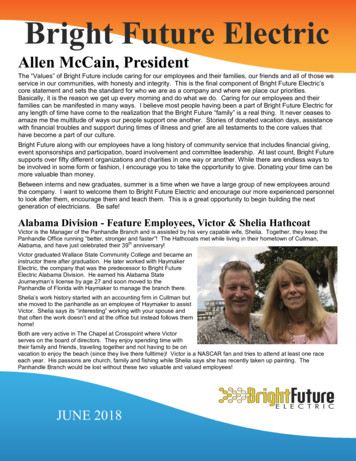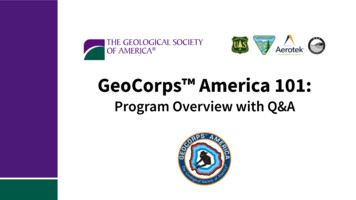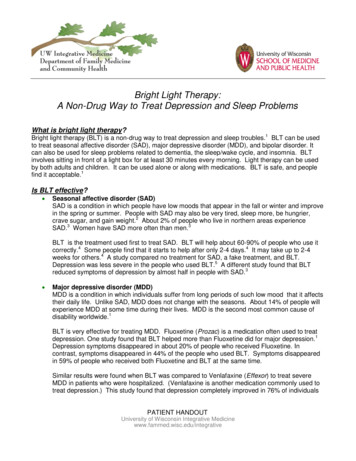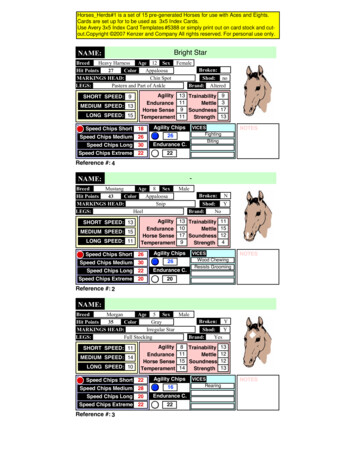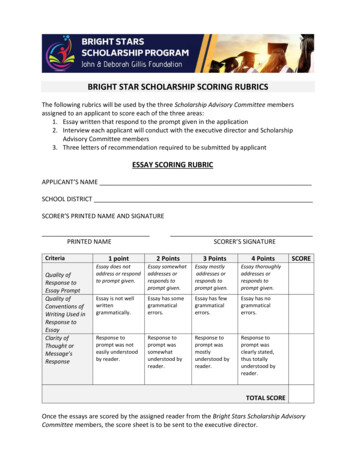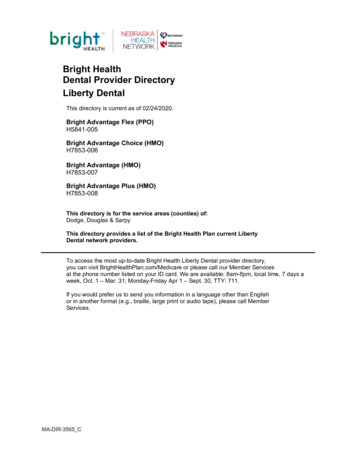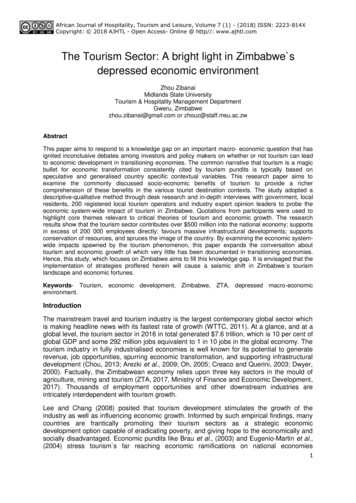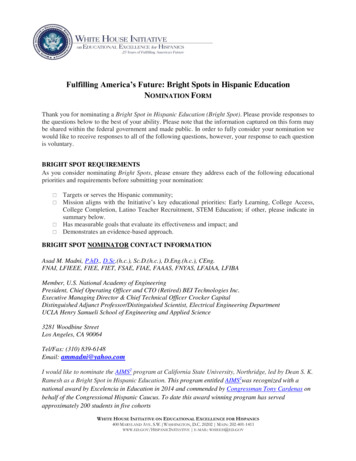
Transcription
Fulfilling America’s Future: Bright Spots in Hispanic EducationNOMINATION FORMThank you for nominating a Bright Spot in Hispanic Education (Bright Spot). Please provide responses tothe questions below to the best of your ability. Please note that the information captured on this form maybe shared within the federal government and made public. In order to fully consider your nomination wewould like to receive responses to all of the following questions, however, your response to each questionis voluntary.BRIGHT SPOT REQUIREMENTSAs you consider nominating Bright Spots, please ensure they address each of the following educationalpriorities and requirements before submitting your nomination: Targets or serves the Hispanic community; Mission aligns with the Initiative’s key educational priorities: Early Learning, College Access,College Completion, Latino Teacher Recruitment, STEM Education; if other, please indicate insummary below. Has measurable goals that evaluate its effectiveness and impact; and Demonstrates an evidence-based approach.BRIGHT SPOT NOMINATOR CONTACT INFORMATIONAsad M. Madni, P.hD., D.Sc.(h.c.), Sc.D.(h.c.), D.Eng.(h.c.), CEng.FNAI, LFIEEE, FIEE, FIET, FSAE, FIAE, FAAAS, FNYAS, LFAIAA, LFIBAMember, U.S. National Academy of EngineeringPresident, Chief Operating Officer and CTO (Retired) BEI Technologies Inc.Executive Managing Director & Chief Technical Officer Crocker CapitalDistinguished Adjunct Professor/Distinguished Scientist, Electrical Engineering DepartmentUCLA Henry Samueli School of Engineering and Applied Science3281 Woodbine StreetLos Angeles, CA 90064Tel/Fax: (310) 839-6148Email: ammadni@yahoo.comI would like to nominate the AIMS2 program at California State University, Northridge, led by Dean S. K.Ramesh as a Bright Spot in Hispanic Education. This program entitled AIMS2was recognized with anational award by Excelencia in Education in 2014 and commended by Congressman Tony Cardenas onbehalf of the Congressional Hispanic Caucus. To date this award winning program has servedapproximately 200 students in five cohortsWHITE HOUSE INITIATIVE ON EDUCATIONAL EXCELLENCE FOR HISPANICS400 MARYLAND AVE. S.W. WASHINGTON, D.C. 20202 MAIN: 202-401-1411WWW.ED.GOV/HISPANICINITIATIVE E-MAIL: WHIEEH@ED.GOV
BRIGHT SPOT CONTACT INFORMATIONThe AIMS2 program at CSUN is nominated for a Bright Spot award. Based on the success of the AIMS2program CSUN was invited by the White House Office of Science and Technology Policy (OSTP) to hostone of the four national White House STEM workshops at CSU Northridge. This very successfulworkshop was held at CSUN on October 7, 2014 and attracted leaders from academia, government, andindustry to discuss efforts to broaden participation in the STEM disciplines, remove barriers, andimprove student graduation rates- especially in engineering and computer science.The AIMS2 program is led by Dean S. K. Ramesh whose contact information may be found below.S. K. Ramesh, Ph.D.Dean,College of Engineering and Computer Science &Professor of Electrical and Computer EngineeringCalifornia State University, NorthridgeCA 91330-8295Tel: 818-677-4501 Fax: 818-677-2140E-mail: s.ramesh@csun.eduURL: ameshBRIGHT SPOT ORGANIZATION INFORMATIONFull Name of the nominee: The AIMS2 program at CSU NorthridgeURL of AIMS2 program: http://www.ecs.csun.edu/aims2Region served: Northridge, San Fernando Valley, and Southern CaliforniaProgram Director: S. K. Ramesh, Ph.D.,Web Address (if applicable): ameshThe primary mission and goals of the program are: To increase the number of Hispanic and low-income students who successfully transfer from GlendaleCommunity College (GCC), and College of the Canyons (COC) to California State University,Northridge, to pursue majors in Engineering and/or Computer Science. To increase the number of Hispanic and low-income students who join CSUN as upper division transferstudents and graduate with degrees from one of the undergraduate programs in the College ofEngineering and Computer Science. To develop a model, seamless and sustainable transfer program to assist Hispanic and low-incomestudents to successfully transfer from GCC and COC to California State University, Northridge wherethey will complete their studies in Engineering and/or Computer Science.BRIGHT SPOT SUMMARYStudents enrolled in the 5 year, 5.5 million HSI-STEM grant (largest in the college’s history) AIMS²cohort program led by Dean Ramesh have access to special mentoring and advisement by faculty,tutoring and peer mentoring, social activities, field trips and opportunities to take part in undergraduate
research projects. Students in the cohorts recorded higher per-term units completed, per-term andcumulative GPAs, and next-term persistence rates compared to their non-participant studentcounterparts. Specifically, student participants (vs. non-participant students) persisted at higher rates:96.7% (vs. 83.3%) for fall 2011-spring 2012 and 97% (vs. 86.7%) in fall 2013-spring 2014. With thesenew pathways in place, transfer student enrollment in engineering and computer science at CSUN fromthe targeted populations in 2013 exceeded the target by 122% and achieved a 210% increase over thebaseline figure from 2010. Other programs in the college include the Teaching to Increase Diversity inSTEM initiative (or TIDES), funded by the Helmsley Trust under the auspices of the Association ofAmerican Colleges & Universities, and the California Career Pathways Trust grant to introduce K-14students to high wage, high growth career fields.BRIGHT SPOT ISSUE AREA(S)The key area addressed by this bright spot is the retention and improved graduation of Latino/a studentsand under-represented minorities in engineering and computer science. Transfer student enrollment inengineering and computer science at CSUN from the targeted populations in 2013 exceeded the target by122% and achieved a 210% increase over the baseline figure from 2010.Cohort students persisted athigher rates: 96.7% (vs. 83.3%) for Fall 2011-Spring 2012 and 97% (vs. 86.7%) in Fall 2013-Spring2014. Program completion exceeded target during the most recent evaluation period (Year 3) of thegrant. 39.2% (60/153) completed a degree program for the most recent period vs. 30.9% (21/68) projecttarget. This also represents an increase over the first project year of 29.3% (22/75), and a slight increaseover the second project year of 38.8% (31/80).CSUN has a strong institutional commitment to increasing participation of Underrepresented Minorities(URM) in STEM serving as the site of the CSU’s system-wide program leadership for the first two phasesof Louis Stokes Alliance for Minority Participation (LSAMP). Also, in 1968, well before the advent ofLSAMP, Dr. Ray Landis, a CSUN Engineering faculty member at that time, established the MinorityEngineering Program model at CSUN, a model that eventually spread nationwide. In this most recentHSI-STEM grant which also represents the largest grant received by the college, the program underDean Ramesh’s leadership has made huge strides to address the academic needs of students in thecohort, that includes proactive academic advisement and tracking, organized tutoring, peer and facultymentoring, hands on research opportunities and project based learning, career advising and eventualtransition to the workforce or advanced studies. Students in the cohort are supported with stipends tomotivate and inspire them to succeed.Students in the cohort were invited by the US Department of Education to create a collaborative webportal where all HSI-STEM grantees across the country can share their best practices and collaborate.The students successfully developed and implemented the portal which is now accessible to all grantees.The students also presented a poster on their work at the system wide CSU STEM summit in April 2015.INITIATIVE CROSS-CUTTING CRITICAL AREASSynergistic activities include visits between the cohort students from the partner colleges as well asoutreach visits by cohort students to other colleges and high schools to raise awareness of the grant andencourage future Latino/a students and other under-represented minorities in engineering and computerscience. Gaps in course articulation agreements between the partner institutions have been identified and
the faculty has been working collaboratively to address them. Based on the success of this initiative theProgram Director, Dean Ramesh was invited to make a presentation on “Best Practices in working withCommunity Colleges” at the 2012 Engineering Deans Institute meeting on April 17th, 2012.One of the key objectives of this grant is the development of sustainable, seamless transfer agreementsbetween the community colleges and CSUN. Faculty from CSUN, GCC and COC has workedcollaboratively to develop and team-teach courses and address the gaps which exist in the articulationagreements. Through the grant they have created a mobile digital environment with iPad’s, tablet PC’sand software, to enhance communication, engagement, collaboration and creativity, and instant learningassessment of the students in the cohort. All cohort students and faculty have been provided with iPad’sfor use in their classes and research projects. Training sessions were offered to faculty members whoreceived the iPad’s to develop curricula and e-texts for use in their classes. Usage statistics reveal thatstudents in cohort 2 used their iPad’s 13,365 times, while those in cohort 3 used their iPad’s 5,554 times.The average usage/student in cohort 2 was 461 and cohort 3 was 617. Students report using their iPad’sto do their homework, access e-Texts and references for their classes and research, as well as peer/socialinteraction amongst fellow cohort member. The WiTEC initiative (Wireless Technology Initiative) underthis grant is a unique collaborative solution that provides a model that other faculty can adapt to theirsubject areas; the wireless classroom is a learning laboratory open to participants from the project teamwho in turn reach and teach interested colleagues, and inform external stakeholders as appropriate.BRIGHT SPOT IMPACTThe AIMS2 program has served a total of 187 students to date in five cohorts (approximately 67 %Latino/a). This includes 100 first-time transfer students at CSUN, 45 students at GCC, and 42 students atCOC. The project team from the three partner institutions consisting of 17 faculty members and 6 staffmembers under the leadership of Dean Ramesh from CSUN meets on a monthly basis to monitor progresson the three primary program goals. Faculty Mentors meet regularly with their students in the cohort todiscuss their academic progress and work with them on research projects. The team has developedcurricula to address gaps in the existing articulation agreements. The overarching program goals aretracked through 12 primary project objectives. These objectives guide the evaluation as an embeddedmixed methods case study design where 35 distinct project performance measures are assessed withbaseline and actual performance data at each campus (CSUN, GCC and COC). The data sourcesincluded AIMS2 students, faculty, staff and institutional data. The data collection procedures employjournal guides, surveys, and interviews. The quantitative measures cover transfer, completion,articulation, advisors, advising, online courses, tutoring, mentoring, supplemental lab, student-facultyinteraction, research participation, and cohort participation. Detailed assessment and evaluation datamay be accessed from the project web site. To date, 32 of 49 (65%) cohort measures have met orexceeded targets. Students in the cohort are required to complete a minimum of 24 semester units/yearand receive an annual stipend of 2,400. 75 % of the students are selected to participate in paid researchprojects ( 15/hour). Cohorts recorded higher per-term units completed, per-term and cumulative GPAs,and next-term persistence rates compared to their non-participant student counterparts. Specifically,student participants (vs. non-participant students) completed an average of 13.3 units (vs. 10.4) in Fall2011, 12.43 units (vs. 11.04) in Spring 2012, 12.19 units (vs. 11.52) in Fall 2012, 12.12 units (vs. 11.18)in Spring 2013, and 12.44 units (vs. 11.09) in Spring 2014. Cohort students recorded a slightly higher
average GPA 2.83 (vs. 2.78) in Spring 2014 and persisted at higher rates: 96.7% (vs. 83.3%) for Fall2011-Spring 2012 and 97% (vs. 86.7%) in Fall 2013-Spring 2014. Overall, the research experiencefacilitated effective cohort interaction with faculty and the application of knowledge relevant to theirmajors with strong mentoring and academic advisement that extended beyond the research setting.Students in the cohort are excelling in their studies, making steady progress towards graduation, andworking closely with faculty and peer mentors who provide academic and career guidance as well asopportunities to work on relevant “hands-on” projects. Recent research projects ranged from simulationsof civil engineering or construction processes to refurbishing lab equipment that hadn’t been used in awhile, the design and fabrication of an intake manifold, and to using an Arduino microprocessor tocontrol a remote-controlled car from a laptop via a Bluetooth interface. Sometimes the projects requiredimprovisation which was an empowering learning experience for the students. AIMS² also has begunleaving its mark on the community college students. At Glendale Community College, it sparked thecreation of a new club, called Supersymmetry, and led to field trips to CSUN and a naval station in SanDiego. At College of the Canyons, AIMS² students and faculty have been meeting monthly for updates,creating a real learning community. The success of cohort students is a testament to the quality andimpact of the program. By way of example from cohort 3 – Catherine Hartnek was elected as thePresident of the IEEE-HKN (Electrical Engineering Honor Society) Lambda Beta Chapter at CSUN.Other cohort students have made presentations on their research at regional and national meetingsincluding CCSC, ASM, SAMPE, and ASEE. Cohort students working under the supervision of theirfaculty mentor – Prof. Gloria Melara won a first Place Award for their poster – “An interactiveclassroom management tool – Class Pi” at the CCSC conference in March 2014. Details on studentaccomplishments may be found online on the project site athttp://www.ecs.csun.edu/aims2/student accomplishments.htmlThis grant is already having an impact on the academic success and career choices of the talented youthin our region, and ultimately, we hope an enduring impact on the growth and health of California’seconomy. As these talented students, who represent both minorities and females, matriculate to theuniversity, they will, in turn, serve as role models for others in their communities. This collaborativepartnership between CSUN, GCC and COC will be instrumental in creating a larger, more inclusive poolof STEM graduates.BRIGHT SPOT PARTNERSThe external advisory committee http://www.ecs.csun.edu/aims2/advisory committee.html consisting ofprominent members from academia and industry meets annually with the project team to review progressin meeting the objectives and offers suggestions for improvement. Internal assessment of the programobjectives and outcomes is being conducted continuously by the Program Assessment and EvaluationCommittee made up of the PI’s of the grant and the internal program evaluator.US DEPARTMENT OF EDUCATION (ED) OR FEDERAL GOVERNMENT INVOLVEMENTThe CSU, Northridge Engineering and Computer Science HSI-STEM Initiative, is funded by the UnitedStates Department of Education FY 2011 Title III, Part F, Hispanic-Serving Institutions (HSI) STEM andArticulation Programs cooperative arrangement development five-year grant, Award NumberP031C110031, CFDA Number 84.031C is a collaborative project lead by the College of Engineering and
Computer Science, in partnership with Glendale Community College (GCC) and the College of theCanyons (COC). It has been recognized by Excelencia in Education in 2014.PRESS ATTENTIONThe AIMS2 program was recognized by Excelencia in Education during their annual awards ceremony inWashington DC in September 2014. Excelencia in Education is a program that accelerates Latino studentsuccess in higher education by providing data-driven analysis of the educational status of Latinos and bypromoting education policies and institutional practices that support their academic achievement. Acommittee of national experts and Excelencia in Education officials selected the college’s Attract, Inspire,Mentor and Support Students (AIMS2) program for special recognition from Excelencia. U.S.Representative Tony Cardenas (District 29) personally attended the celebration to congratulate DeanRamesh and the program on behalf of the Congressional Hispanic Caucus.Dr. Ramesh has recently been selected to be part of an elite group of extraordinary CEOs. MillerIngenuity CEO, Steve Blue looks across the country and hand picks expectation-shattering leaders to be apart of his League of Extraordinary CEOs. While Ramesh is not a CEO, Blue has made an exception tothe rules for his exceptional accomplishments within engineering academia and dedication to preparingthe next generation of innovative engineers and scientists to lead us into the future. His efforts to providecutting edge programs in the engineering and science fields to lead us into the future may be accessedfrom the full Blue-Ramesh interview in the Business Journal: League of Extraordinary CEOs: S.K.Ramesh.In 2014 Ramesh was invited by the White House Office of Science and Technology Policy (OSTP) to hostone of the four national White House STEM workshops at CSU Northridge. This very successfulworkshop was held at CSUN on October 7, 2014 and attracted leaders from academia, government, andindustry to discuss efforts to broaden participation in the STEM disciplines, remove barriers, andimprove student graduation rates- especially in engineering and computer science. Besides organizingthe entire event, Dean Ramesh was responsible for organizing and leading a workshop on “Connectionsto Industry and Careers” – which was a key theme during the College Opportunity Summit hosted by thePresident and the First Lady on December 4, 2014.
the faculty has been working collaboratively to address them. Based on the success of this initiative the Program Director, Dean Ramesh was invited to make a presentation on “Best Practices in working with Community Colleges” at the 2012 Engineering Deans Institute meeting on April 17th, 2012. One of the key objectives of this grant
